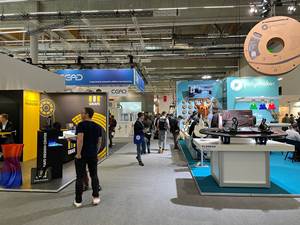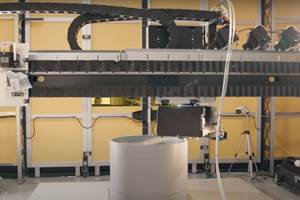The Third Bucket and the Conversion of Production: A Perspective on Polymer Development for AM
Sabic sees 3D printing taking plastics where they have not gone before, but end-user needs will push the capabilities of 3D printers.
When Keith Cox talks about 3D printing, he refers to it as a “conversion process.” That phrase is an important clue to the role 3D printing is destined to play and the way that companies like his employer will figure in. I recently had a conversation with him about polymer development for additive manufacturing.
Cox works for SABIC, supplier of polymer materials, where his role is senior business manager for AM. From his and this company’s perspective, 3D printing is indeed another conversion process, one more means (like injection molding, blow molding or extrusion) for converting the raw stock from SABIC into a finished good. The different processes behave in different ways and make different demands on the material. And while 3D printing is the newest such process to appear, tailoring materials to the needs of a conversion process is what the company has been doing all along. In this sense, supporting additive manufacturing as it finds a growing role in production is simply more of the same.
But in another sense, AM represents a very different set of challenges for the company. And a different opportunity, because 3D printing promises to grow the very market potential for plastics by expanding what it is possible for plastics to do.
Realizing a polycarbonate delivering roughly similar properties after injection molding or 3D printing entails starting with different formulations of the raw stock tuned to these different processes.
The challenges first: 3D printing is physically a very different operation from other conversion processes. In fact, it is different operations, plural, because AM processes such as selective laser sintering (SLS) and fused filament fabrication (FFF) differ from one another. But both these processes differ markedly from established means of working with plastic such as injection molding. Consider: Injection molding is a hot, high-pressure, short-cycle-time process—the mold slams shut as high-temperature material is injected in. By contrast, both SLS and FFF are processes involving little pressure, run only at the melting or extrusion temperature of the material, with a cycle time lasting so long that the material might remain at or near this temperature for hours at a time or even a day. Thus, realizing a polycarbonate delivering roughly similar properties after injection molding or 3D printing entails starting with different formulations of the raw stock tuned to these different processes.
The other, bigger area of challenge relates to how dynamic additive still is, and how much is still changing. “The maturity level of the AM space today makes material development complex,” he says. “These processes are all evolving. Even in FFF over the last five years, we’ve seen tremendous change in the 3D printing technology. So, we’re at a disadvantage both because there is not a lot of history with these processes and because there continues to be a lot of change.” And that change plays out not only in the machine hardware, but also in the design and simulation software, which are also advancing and can also affect material application.
But it’s all worth it, and the reason why gets to the opportunity. 3D printing is fundamentally different from other conversion processes because there is no tooling needed. There is no mold, for example. That opens the range of part geometries that can be achieved, while reducing the production quantities that might be cost-effective. Because of both areas of freedom, 3D printing will be an enabler for the advance of polymers. By delivering both previously impossible forms and previously impractical solutions, 3D printing will bring plastics into applications it was never able to serve before. Polymer developers obviously see high value in being part of this.
Indeed, the opportunity today falls into three categories, says Cox—“three buckets,” he says—and the most important one is the bucket most affected by the capabilities of today’s machines. Those buckets are:
- Drop-in material replacements. In this area of materials development, the supplier can develop its own, more competitive version of some existing material option—say, its own version of a polycarbonate filament for FFF similar to an existing version.
- New materials for standard print profiles. Within the sets of printer parameters used for established materials, the materials company might be able to engineer new materials with special properties. A new SABIC filament delivering high toughness for consumer electronics and automotive applications is an example.
- New materials leveraging non-standard print profiles. This third category is the most exciting area of material development. The most promising new material options tend to push 3D printers by requiring operational parameters different from the parameter sets locked into established machines—machines that might have been invented with prototyping rather than production in mind. For example, polymers engineered to withstand high-temperature applications need printers not only able to achieve the required high extrusion temperature, but also able to give the operator the capacity to employ that temperature. Another material might require a distinct and specific print speed or layering height. Machines offering an “open format”—that is, user ability to adjust machine settings governing the build—are becoming more valuable as materials advance, Cox says.
Related Content
What Is Neighborhood 91?
With its first building completely occupied, the N91 campus is on its way to becoming an end-to-end ecosystem for production additive manufacturing. Updates from the Pittsburgh initiative.
Read MoreAdditive Manufacturing Is Subtractive, Too: How CNC Machining Integrates With AM (Includes Video)
For Keselowski Advanced Manufacturing, succeeding with laser powder bed fusion as a production process means developing a machine shop that is responsive to, and moves at the pacing of, metal 3D printing.
Read More10 Important Developments in Additive Manufacturing Seen at Formnext 2022 (Includes Video)
The leading trade show dedicated to the advance of industrial 3D printing returned to the scale and energy not seen since before the pandemic. More ceramics, fewer supports structures and finding opportunities in wavelengths — these are just some of the AM advances notable at the show this year.
Read MoreLarge-Format “Cold” 3D Printing With Polypropylene and Polyethylene
Israeli startup Largix has developed a production solution that can 3D print PP and PE without melting them. Its first test? Custom tanks for chemical storage.
Read MoreRead Next
Postprocessing Steps and Costs for Metal 3D Printing
When your metal part is done 3D printing, you just pull it out of the machine and start using it, right? Not exactly.
Read More3MF File Format for Additive Manufacturing: More Than Geometry
The file format offers a less data-intensive way of recording part geometry, as well as details about build preparation, material, process and more.
Read MoreCarnegie Mellon Helps Industry, Students Prepare for a Manufacturing Future with AM and AI
Work underway at the university’s Next Manufacturing Center and Manufacturing Futures Institute is helping industrial additive manufacturers achieve success today, while applying artificial intelligence, surrogate modeling and more to solve the problems of the future.
Read More





















